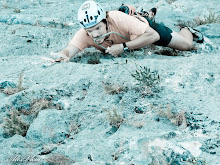
I just got done attending greenbiz.com's webinar called Carbon Strategy, which is what I will discuss a little here today. And starting next week, I will be attending a two week course in alternative energy development provided by the Valencian Government here in Canet Den Berenguer, Valencia. I will be happy to try to share the information that I will be learning with the rest of the world via TREVORLANDIA: business and other cool issues.

In today's webinar, we received a brief overview of creating a carbon strategy. We started out by asking why? Well I guess the most prominent reason, other than the actual climate change, would be that there has been increased sustainability pressures. Those pressures have come from society in general and being part of the business community. Other pressures are coming from government regulations, although they are quite minimum. There are also marketing pressures because we are seeing more and more brands align themselves with green initiatives and those brands that don't may be frowned upon. Finally, investors are becoming more demanding. Mostly because it is more efficient to become sustainable and therefore secures higher returns over the long run.
So now that we have some good reasons to implement a carbon strategy. What are the environmental impact areas of business? And what functions of business affect those areas?
Surely we can say that energy, carbon, water, and waste are the 4 most relevant impact areas in operations and in products. So we must be aware of these four impact areas when we begin to study our operations and the products that we are making. Furthermore, those areas can be broken down into emision scopes. For example, scope 1 would be your business' direct impact (vehicle fleet). Scope 2 would be indirect impacts such as energy purchased from utility companies and your scope 3 would be other impacts such as in the supply chain to be able to provide your service or products.
Ufff....thats a lot to work on! Where does one begin. First, it is always helpful to have director support on project of this magnitude and if you are the director, excellent! It will now just depend on your own motivation to help save the planet. However, if you aren't keep bringing the topic to the table in your projects and meetings with the directors, talk with co-workers, and start your own internal movement without stepping on anybody's feet.
If you are your own boss or have a role like mine where you have a direct influence on the directing team of the business, get started by determining your strategy profile, set goals and objectives (try starting small first), then set up a structure to be able to manage these changes in the organization. Later you'll want to implement a reporting program by planning and measuring those plans with some sort of measurement tool. It always helps to make sure your right by hiring an external auditor. You might find it easier to go straight to optimizing your business activities by reducing raw material purchases, energy consuption or finding renewable sources and recycling all your waste in some manner. You might even be able to restore some of those materials or activities. Every business is different and only you can understand and apply these concepts. When you've been working on this a while, give it an evaluation. Identify your top emmitors and rate yourself on your performance.
On the marketing side and internal management side, communication and transparency is vital.
The webinar's case study was by AT&T but thier practices are quite new however applicable for every business. For example, they have started finding ways to green up the data center, which every business can do. They have also looked into finding alternative energy sources for facilities and thier vehicle fleet. You can, too! For more complex situations, managers can find energy saving software for machines and streamline real estate (whatever that means??).
Needless to say, there is a lot of re-directing investment that has to happen for all this to take place. Unless you have an endless bucket of money (if so, contact me because I would like to work for you!), it is probably best to start small and work in larger projects as opportunities arise or as your investors start aligning to your motivation if they aren't already. It was said that pay-back times vary depending on goals, objectives, and the scope of projects at hand, but most businesses can see returns from 18 months to 6 years.
Summit Energy is one of the leading companies that help businesses track their carbon footprint. Just tell them you saw it on TREVORLANDIA and ask for Bill Brewer.















